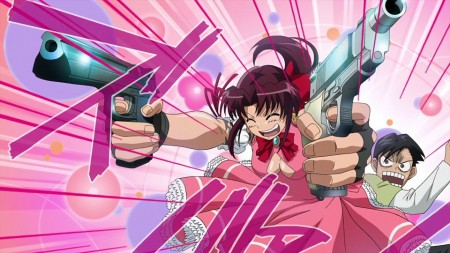Ask John: What Are the Best Omake Anime?
Question:
Having recently discovered the “fake Mai-Hime Movie” trailer featured as an extra (omake) on one of the DVDs of the My-Otome TV series – if it were genuine, I’d buy the movie when it became available (lol) – as well as learning of a”fake” trailer for The Soultaker Movie (contained only on Japanese VHS or DVD), are there any other more noticeable examples of “omake” that come to mind?
Answer:
The Japanese word omake means “bonus” or “extra.” It’s usually refers to an unexpected little extra gift added onto a performance. (The bonus freebies included in anime & manga magazines, like posters, stickers, CDs, and shitakiji are known by a different name: furoku). Since omake typically refers to something brief and small, full length home video exclusive episodes generally aren’t considered omake. Typically anime omake are fairly routine, like non-text opening and ending animation sequences, or perhaps a bonus music video. However, occasionally anime productions go the extra mile to include especially interesting, unique, or unusual omake in the form of new animation. I’m certain that I’m not familiar with all of the existing unique anime omake, and I’m sure that I’ll forget some of them worth mentioning. But a few memorable examples to spring to mind.
In the early 90s, Gainax seemed to be the king of exceptional omake. The Japanese home video release of Secret of Blue Water included ten bonus anime shorts ranging from roughly three minutes up to six minutes in length. These shorts provided additional detail and insight into the world of Nadia. Unfortunately, these shorts have never been officially released in America. The Gunbuster: Aim For the Top OVA series also included omake in which ironically super deformed characters explained the complex scientific principles that provided background for the series. However, bonus animation isn’t limited to just these two titles. Production I.G’s Blue Seed television series included 13 short humorous omake sketches similar to the Nadia omake. The first Fushigi Yuugi OVA series included three super deformed mini-episodes revolving around the characters visiting a hot spring resort. The Lodoss War television series also included bonus super deformed “Welcome to Lodoss Island” omake episodes.
Omake episodes seem to be getting more common lately. Perhaps they’re increasing being used as an extra incentive to entice consumers to purchase home video releases than used as the sort of “bonus service” that they were originally designed as. If Gainax was the king of anime omake during the 90s, animation studio ARMS may have taken the crown in the early 2000s with its bonus mini-episodes for the Ikkitousen and Queen’s Blade anime series. A number of other fairly recent productions have also included memorable and comical bonus mini-episodes, including Dai Mahou Touge, Maria-sama ga Miteru, the Japanese Blu-ray release of the Black Lagoon television series, Kanokon, and Ladies vs Butlers. The Toaru Kagaku no Railgun omake episodes are particularly hilarious and memorable because they’re so extremely bizarre.
While memorable omake are most often entirely original animation, memorable omake don’t necessarily have to be bonus mini-episodes. The Umineko no Naku Koro ni television series omake are brief excerpts of episode footage with new, risqué dubbing. And perhaps the greatest ever omake that isn’t a bonus short episodes is the Jackie-chan movie style outtakes that roll with the ending credits of the 1986 Rumic World: Supergirl OVA. Apart from the fact that they’re hilarious, a moment of consideration forces realization that these bloopers aren’t unused footage; they had to be custom drawn and animated just to seem like cutting-room floor footage.
Add a Comment
You must be logged in to post a comment.




I rather liked the idiotic “Tachikoma Days” specials for Stand Alone Complex: http://www.youtube.com/watch?v=PvqXDa08fyQ&fmt=35
“Fight! Ippatsu! Juuden-chan” had pretty extensive omakes in each of the six DVD volumes. I think they’re excellent, very sexy and also very funny.
“Kanokon” also had omakes in each DVD, but they’re not very good. Pretty much each of them is about Wolfie and Foxie trying to seduce wimp-boy. Except that one of them is brilliant, a video interview of Wolfie that’s a take on certain kinds of live porn videos.
“Ladies versus Butlers” had omakes which are nothing but cheesecake. No plot, little characterization, no humor. They made me uncomfortable.
“Ikki Tousen” had omakes which, taken together, represented a single story. It’s a trifle; all the girls end up at an onsen. The sequel series all do similar things.
These days a lot of omakes are used to deliver ecchi imagery which couldn’t be broadcast. “Ichiban Ushiro no Daimaou” is coming out now on DVD and that’s what its omakes are turning out to be.
One you forgot were the Outtakes on the Berserk DVD release. I believe it is on the American DVD’s only, but they re-dub moments in the anime with audio commentary. The length of each ranged from 3 to 12 minutes and the re-dubs ranged from pretend outtakes like they were real people in a real movie to new dialog for the shot. They were all hilariously stupid.